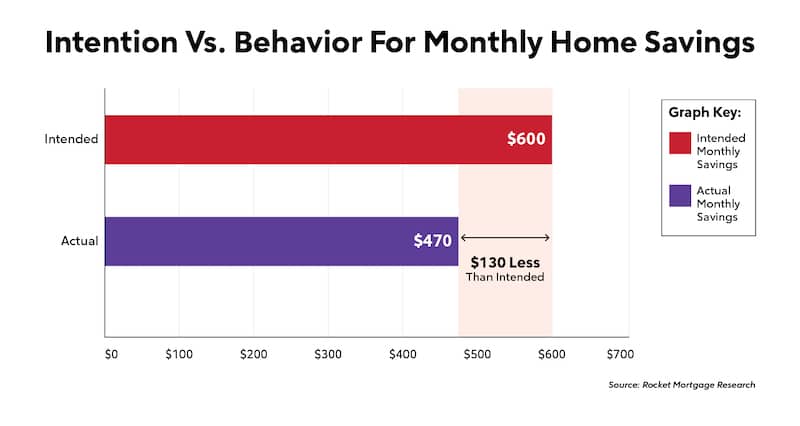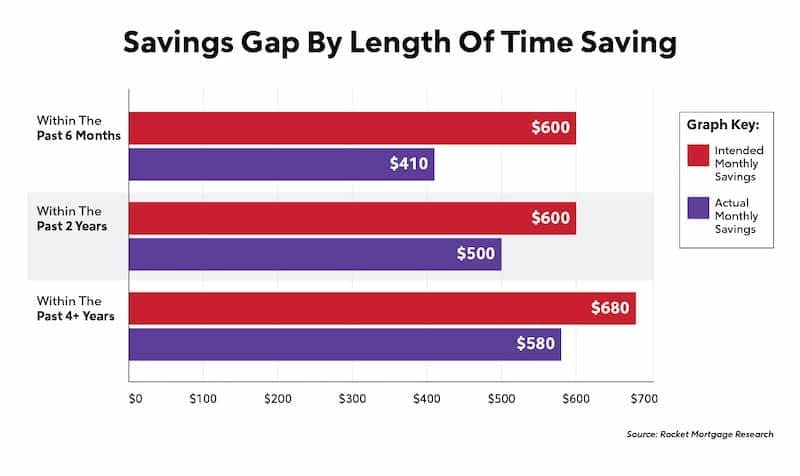Data Shows Why Saving For Your First Down Payment Can Be Hard

Author: Isabel Lenzen
There’s often a discrepancy between the things that people intend on doing and what they actually get done. In social psychology this is called the “intention behavior gap.”
Previous research on the intention behavior gap shows that across a wide variety of behavior domains, there is, on average, a statistically significant gap in every tested behavior domain between what people intended versus what they actually did. This gap infiltrates many areas in life, including finances – which, in turn, could affect one’s dream of homeownership.
Of first-time home buyers, 46.5% report that their biggest consideration or concern in the home buying process is down payment. Knowing that saving up for the down payment is one of the biggest challenges in buying a first home, Rocket Mortgage® surveyed 1,000 first-time home buyers using the framework of the intention behavior gap. This survey was designed to see if and to what extent first-time home buyers’ intentions to save money every month for their first home is in line with what they’re actually saving. The intention behavior gap could be key to explaining why first-time home buyers are struggling to save for their first down payment.
First-Time Home Buyers Are Saving 22% Less Every Month Than They Intend

Respondents were asked, “how much of your budget do you intend to put aside each month for your first home down payment?” followed by, “how much of your budget do you actually put aside each month for your first home down payment?” On average, respondents intended on saving $600 each month and are actually saving $470 in preparation to buy their first home. That intention behavior gap is $130 each month, which means first-time home buyers are saving $1,560 less than they intend to yearly.
When considering first-time home buyer programs like the FHA loan, which only requires 3.5% down, and the current national median sale price of homes in the U.S. being $416,100, first-time home buyers could be almost 7 months closer to being ready to buy a home if they saved as much as they intended.
Top Three Reasons for Intention Behavior Gap
Knowing that there are several external and internal factors that could be affecting or be used to rationalize this gap in savings, we asked respondents with a savings gap what their reason is for not saving as much as they intend.
The top three reasons first-time home buyers aren’t saving as much as they intend each month for their down payment include:
- Other saving priorities (33%)
- Change in or loss of income (31%)
- Higher than anticipated household expenses (27%)
While these reasons are certainly valid, it seems those who have been saving longer may be using their experience to find ways around such obstacles.
Experience Saving May Be The Best Teacher: Those Who Have Been Saving Longer Are Saving More

On average, the intended versus actual savings gap drops by 17% when comparing first-time home buyers only saving for 6 months to those who’ve been saving for 4+ years.
Assuming these longtime savers are likely closer to buying a home, because of their commitment and average amount saved, this may indicate the possible role that motivation can play to close the intention-behavior gap. Specifically, once one starts getting closer to being ready to buy, they’re possibly a lot more motivated to close that gap/behave in line with their intention. Said another way, it may increase the intention centrality, which is known to tighten the relationship between intention and behavior. If a first-time home buyer has been saving for years and knows they are only a couple thousand dollars away from having enough for their down payment, they are more likely to be driven to save as much as they can each month to get to their goal.
Financial Media Consumption Is Not A Factor In More Savings
One factor many may find surprising is that those who consume financial media were less likely to save closer to what they intended. When considering how self-reported consumption of financial media, information or news could affect respondents’ savings gap, data showed that those who say they “regularly” consume financial media see a slightly larger savings gap versus consumers who are less inclined toward consuming information from these sources.
After grouping respondents into levels of high and low financial engagement based on frequency of consuming financial media, the high financial engagement group’s average gap showed $160 less than the amount they intended to save each month, whereas and the low financial engagement group’s average gap was $90 less each month than intended.
While financial media consumption may not play as big of a role in some peoples’ ability to save, data shows that salary might.
Gig Workers Are Better Savers Than Hourly or Salary
Although the finding is directional, research suggests that gig workers might show a smaller intention gap than workers paid through traditional structures (salary/hourly).
Monthly intended versus actual savings by pay type were as follows:
- Gig/Project Workers: Intended $650, Saved $630 (3% gap)
- Salary: Intended $820, Saved $690 (16% gap)
- Hourly: Intended $500, Saved $400 (20% gap)
Gig workers may be better at behaving in line with behaviors because they are more realistic with their intentions. With gig workers knowing that their income is variable, they could be setting more practical goals for themselves compared to those whose income is fixed.
Intentions Alone May Not Suffice When Saving For Your First Down Payment
Our research shows that the intention behavior gap does in fact pose a significant challenge for first-time home buyers preparing to buy their first home. With an average gap of 22% less (or $130 less) saved each month than intended, future buyers need to be prepared for the reality of how difficult it can be to stick to a savings plan. However, saving does get easier with time as buyers become more motivated to close their gap.
Understanding the "intention behavior gap" highlights the need for realistic goal setting and acknowledging that intentions alone might not suffice. First-time buyers can benefit from aligning their intentions with feasible actions, adjusting priorities and anticipating income fluctuations as they prepare to buy their first home.
Methodology
In order to understand how the framework of research on the intention behavior gap could affect first-time home buyer savings, Rocket Mortgage collaborated with AYTM to survey 1,000 U.S. adults 18 and up that are not current or previous homeowners. Respondents also had to have been planning to purchase their first home in the next 5 years. Respondents were asked about their monthly intended home savings, actual monthly home savings, how long they’ve been savings, as well as other profiling question to understand their potential gap. The survey was censused balanced on age and gender. This survey was completed on August 7, 2023. The current national median sale price of homes is current as of Q2 2023, according to FRED Economic data.
This article was originally posted on RocketMortgage.com